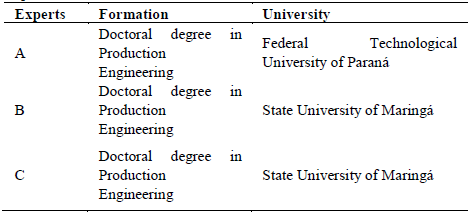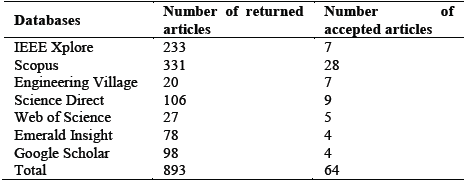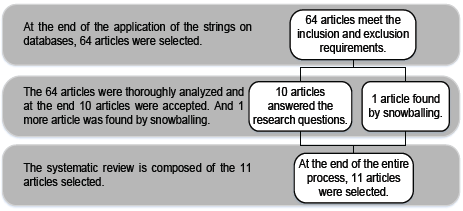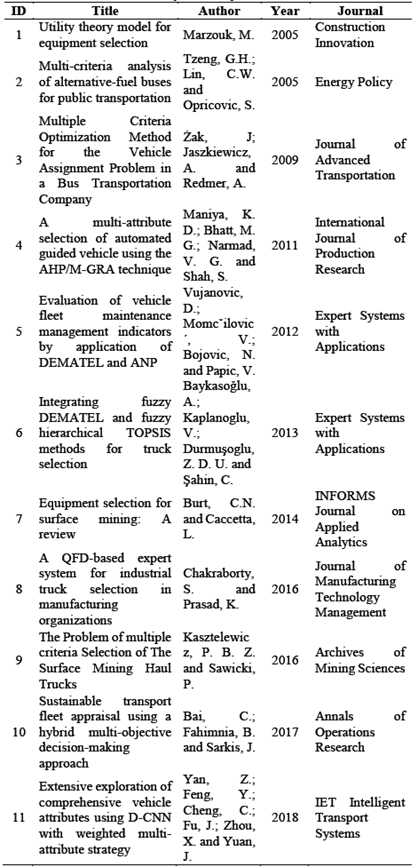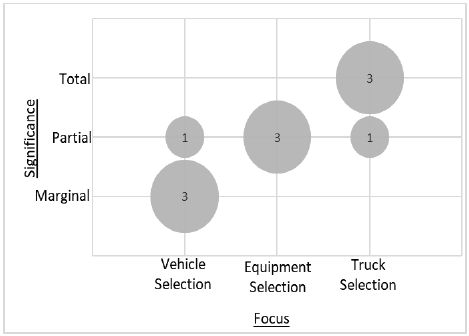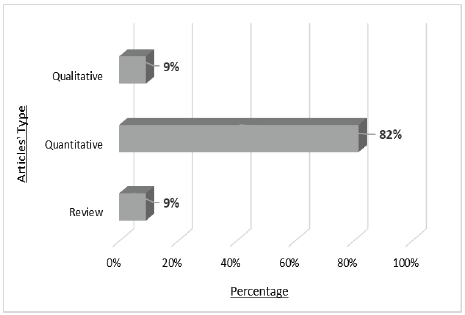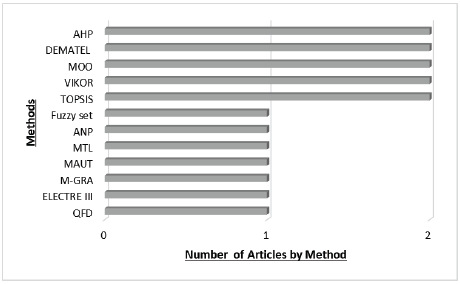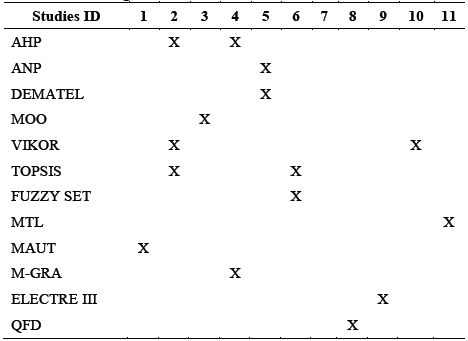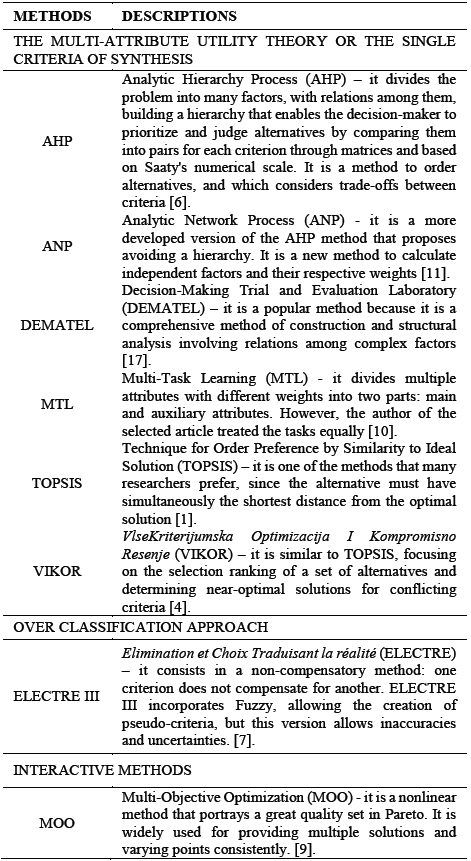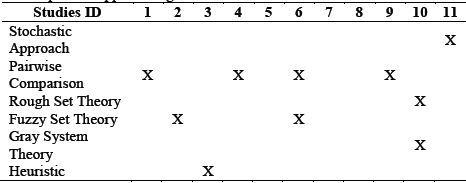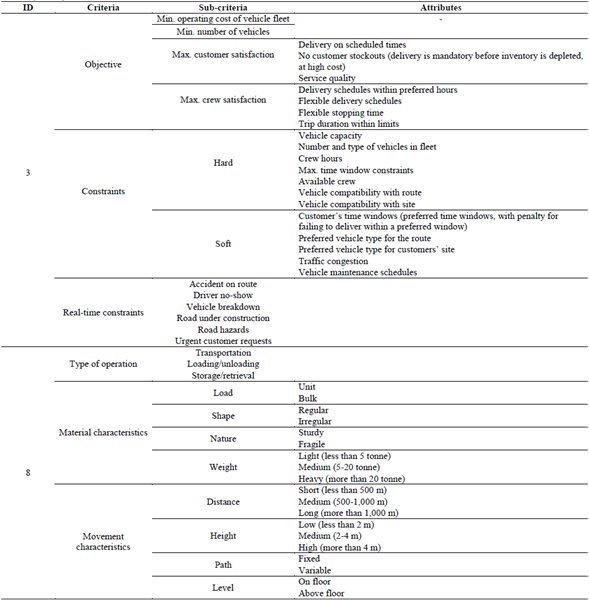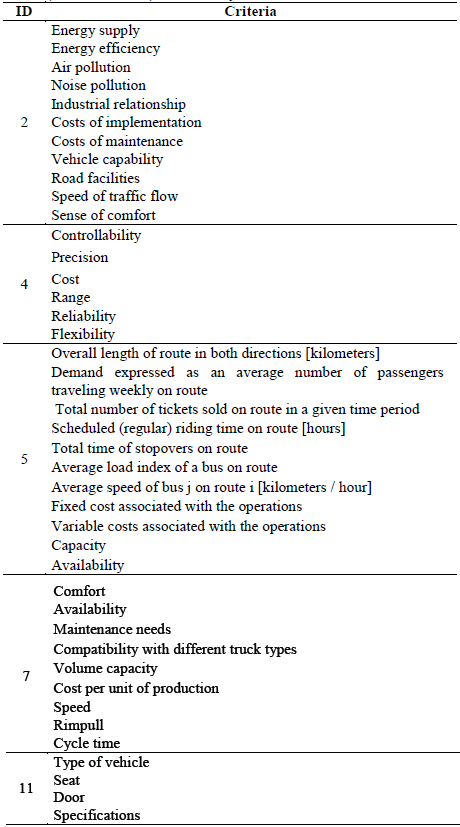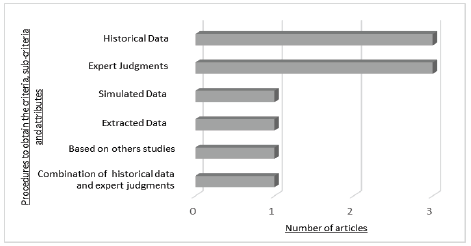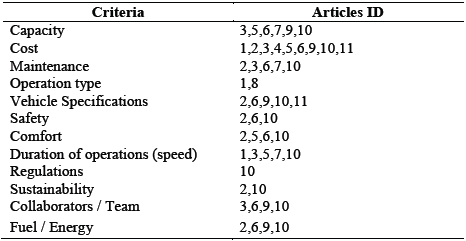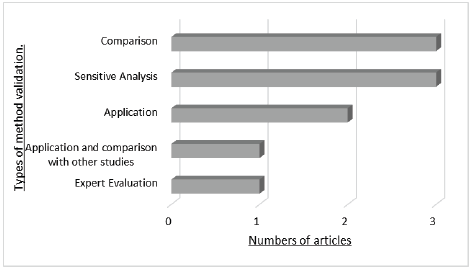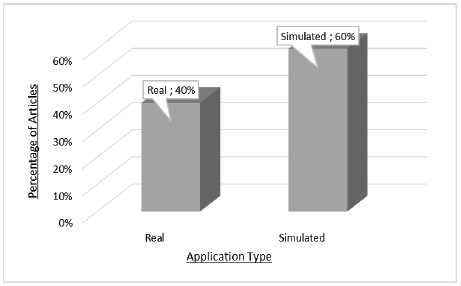1. Introduction
The complexity of making a decision increases according to technological advances and the range of alternatives and products. To filter all the possibilities, decision-makers consider a set of criteria and goals in evaluations to make a decision.
In order to reduce the complexity of problems with multiple decision criteria, researchers have developed tools and methods to help find the best solution [2]. MCDM (Multicriteria Decision-Making) Methods can be classified in many ways. One of them uses characteristics to classify the methods as multi-attribute (MADM, Multi-Attribute Decision Making) or multi-objective (MODM, Multi-Objective Decision Making). Another classification is presented by Guarnieri (2015): Multi-Attribute Utility Theory, Interactive Methods or Over Classification Approach [6].
Equipment selection is an important decision for many industrial processes, with many criteria to consider. In particular, the selection of transportation equipment used for loading final products or raw materials is a pivotal decision that may impact organizational performance on a positive or negative way.
The truck selection issue is a practical problem that aims to rank various truck models (decision alternatives) based on a set of evaluation criteria. There are several criteria that can be adopted by decision-makers to assess the alternatives, such as cost, time, maintenance ease, availability, failures, sale ease etc. However, many of these criteria cannot be accurately assessed, so subjective assessment is required [1,5,15].
In this context, this paper presents a Systematic Literature Review (SLR) that seeks to identify studies on the use of MCDM Methods in truck selection in order to identify criteria, sub-criteria and techniques applied to solve the problem.
2. Systematic literature review
Systematic literature review (SLR) is a research approach that uses literature as its sources. In the scientific field, SLR is characterized by identifying research questions and justifying future studies. Designing a systematic review implies developing a search strategy, taking well-defined steps and establishing exclusion and inclusion criteria for the references [14].
The main goal of a SLR is to synthesize existing studies that will serve as evidence for the further work. It is structured by a review protocol that specifies the research and its goals, as well as the methods that will be used to avoid biased results and also allow replication [8,13].
Planning a SLR involves specifying research questions, developing and evaluating a review protocol, searching and selecting articles, extracting and analyzing data and also reporting the results obtained. Therefore, the need of a SLR arises from researchers’ desires to summarize all literary information about any study theme. Specifying the research questions is considered the most important task, as the review revolves around these questions, and the studies found should answer them [8].
The review protocol is a guide that aims to clearly and transparently record and describe the review methods and strategies that will be used for performing the SLR. It is necessary to minimize the risks of systematic errors or decisions made by “guesswork” [3].
For this study, the following steps were considered:
Plan: The protocol, in which the search process and the study extraction methods were defined, was elaborated.
Research Protocol Evaluation: Due to the significance of the protocol in SLR elaboration, and following the guidelines by Kitchenham (2007), the study was submitted to a protocol evaluation by independent experts. This assessment was applied using Google Forms tool, through which experts were invited to take part in a survey. The results of the protocol evaluation are presented and discussed in the following sections.
Protocol Refinement: Considering the data collected in the previous step, the protocol was analyzed again, taking into consideration the experts' indications, and, then, it was modified.
Systematic Review Execution: At this stage, actions predefined in the review protocol were performed.
The protocol evaluated by three independent experts resulted in many responses presented in Appendix A, and experts’ profiles are presented in Table 1.
2.1. Research questions
Research questions serve as a guide for SLR, shaping the information obtained to achieve the aim of the study, avoiding unnecessary information and keeping the focus of the research. These are the research questions:
What are the quantitative or qualitative decision support methods used to select trucks or vehicles?
What are the criteria and sub-criteria used?
What procedures are used to determine and/or evaluate the criteria and sub-criteria?
Was any computational tool used? If so, which?
What application type (real or simulated) was used?
How were the data to evaluate the trucks (or vehicles) obtained?
2.2. Search Strategy
The approach to the search process should combine automatic and manual search, because the former has a longer reach, and the latter ensures that no article has been left behind [8].
The databases used to select the papers were chosen based on reviews by Lima Jr., Osiro and Carpinetti (2013) and Lima Jr. and Carpinetti (2017). One of them was suggested by one of the experts. Here they are:
IEEE Xplore (https://ieeexplore.ieee.org);
Scopus (https://www.scopus.com);
Engineering Village (https://www.engineeringvillage.com);
Science Direct (https://www.sciencedirect.com);
Web of Science (apps.webofknowledge.com);
Emerald Insight (www.emeraldinsight.com);
Google Scholar (https://scholar.google.com.br).
Correct determination of the keywords is really important, because the exclusion and inclusion criteria start at that stage. These criteria depend on the sequence of strings, thus, working as a primary filter [16].
An alternative in terms of approach is breaking the questions into individual words, then list the synonyms and abbreviations for each one of them. Other terms can be determined through combinations and adaptations of other systematic reviews [8].
Therefore, the search strings were constructed by using connectors AND and OR, which resulted in the following combination: {multicriteria* OR (multiple criteria)* OR (multi-attribute)* OR (decision-making)*} AND {truck* OR (road transport vehicle)* OR (freight transport)* OR vehicle* OR (transport vehicle)* OR (freight vehicle)* OR (loading vehicle)* OR fleet* OR (truck fleets)* OR cart*}.
Selection strategy
The selection strategy identifies the first studies that answer the research questions in a most direct way. In order to select only studies aligned with the systematic review scope, the exclusion and inclusion criteria determined should be based on those questions. These criteria should ensure reliable interpretation and correct classification [8].
The exclusion criteria defined are:
Not written in English;
Obsolete (over 15 years);
Not peer reviewed (gray literature);
Not related to vehicle selection;
In case of duplicate publications or those with the same results, the most complete one is kept;
Papers that do not adequately answer the research questions;
Not available online.
The inclusion criteria defined are:
The papers that include the selection criteria, techniques, and/or tools used to support truck selection.
The exclusion and inclusion criteria were based on other systematic reviews, on difficulty to find results and on the experience of authors b, c and d, besides being evaluated by three other experts.
2.4. Extraction Strategy
The search was done in November 2018, on the databases presented in Section 2.2, to find the primary studies. They were extracted and inserted into the StArt.1 Software. Through that tool, duplicate publications were ruled out, and the titles, abstracts and keywords of each study were read. The reading stage lasted two months and took place from December 2018 to January 2019.
Table 2 presents the number of returned articles during the application of the strings and the number of accepted ones at the end of the procedure explained above, both related to their databases.
The 64 resulting articles were fully read (including those kept in case of doubt) and analyzed according to the inclusion and exclusion criteria presented in Section 2.3. In this step, we also analyzed how each article answered the research questions. The entire process started in February and finished in March, 2019.
At the end of the reading stage, 11 articles were accepted for answering the research questions previously proposed in the elaboration of the protocol. One of them was obtained by snowballing. Fig. 1 demonstrates the steps and results of the selection process.
3. Characterization and Results Discussion
Table 3 presents the selected articles, describing title, author, publication year and journal.
During systematic review elaboration, the lack of articles focusing on the truck selection problem became evident. Therefore, it was essential to accept articles that addressed vehicle selection and industrial locomotive equipment problems. We also observed if the criteria, sub-criteria and techniques could be applied to the truck selection problem.
Thus, a bubble chart was devised to demonstrate the distribution and relationship of the selected articles in relation to significance and focus, as presented in Figure 2.
The articles significance was classified as total, partial or marginal by evaluating to what extent they are related to decision making regarding the truck selection problem, according to their focus.
Fig. 2 shows that the intersection between the highest level of significance (total) and focus (truck selection) returns 3 articles. However, we found an article focusing on equipment selection with a medium level of significance, as trucks are considered transport equipment in industries.
Thus, considering the whole set of articles, 82% were characterized as quantitative, 9% as qualitative and the other 9% as literary reviews, as presented in Fig. 3.
3.1. Methods
There is a large number of methods applicable to many multicriteria problems, but the most used ones when it comes to vehicle selection are AHP (Analytic Hierarchy Process), DEMATEL (Decision-Making Trial and Evaluation Laboratory), VIKOR (VlseKriterijumska Optimizacija I Kompromisno Resenje), TOPSIS (Technique for Order Preference by Similarity to Ideal Solution) and MOO (Multi-Objective Optimization). They can be combined with other techniques or methods.
Fig. 4 presents all methods used by the 11 articles in relation to the number of studies. However, considering the 12 methods, only Quality Function Deployment (QFD) is not a decision method, but rather a quality tool that translates customer needs into product or service characteristics, as a qualitative tool that is rarely used in decision-making.
Table 4 shows which methods were applied by each study. It is possible to observe that some studies adopted more than one method. For instance, study 2 applied three methods (AHP, VIKOR and TOPSIS).
Taking into account the quantitative articles, 70% applied hybrid methods (any model generated by combining two or more techniques) and 30% applied a single method with no combinations. That leads us to conclude that hybrid methods are more recurrent, which is due to the need of adapting a method to certain problems or addressing its weaknesses.
So, nine studies used only MCDM methods. Study 7 does not present any method, for it is a literary review, and study 8 used a qualitative method. From the studies presented in Table 4, seven (2, 3, 4, 5, 6, 10 and 11) applied hybrid methods. However, the methods applied by studies 3, 10 and 11 are considered hybrid because they used modified methods with parts of other MCDM techniques and/or other methods of calculus. Although the researchers did not modify the name of those methods, they refer to the approach used as a hybrid model.
Table 5 presents all the methods listed in Table 4 according to Guarnieri’s (2015) classification, explained in Section 1.
In order to achieve a good result, different types of data can be modeled by approaches such as Pairwise Comparison, Fuzzy Set Theory, Stochastic Approach, Rough Set Theory, Gray System Theory and Heuristic. These techniques contribute in many ways to the calculations, but most of them directly impact on how the alternatives will be treated and what kind of results will be accepted. Therefore, Table 5 presents data approach techniques in relation to the selected studies.
As study 6 applied two Fuzzy methods (Fuzzy DEMATEL and Fuzzy Hierarchical), both are variations of The Single Criteria of Synthesis Approach. The Fuzzy Set methods incorporate a fuzzy number scale in order to represent the decision maker's hesitation in numbers [6].
3.2. Criteria and sub-criteria
The criteria of each article are presented in Tables 6, 7 and 8. This division was performed because some studies have only criteria, others have criteria and sub-criteria and others comprise criteria, sub-criteria and attributes.
Criteria, sub-criteria and attributes are data of extremely importance for decision-making support methods. It is through them that the constraints and conditions of the mathematical models are elaborated. Having that in mind, the way they are selected is of utmost importance and they can be determined by historical data, expert judgments, based on others studies, extracted data, simulated data, as well as a combination of them. Thus, Fig. 5 shows the number of articles that used each of these procedures to obtain the criteria, sub-criteria and attributes needed to evaluate the alternatives.
Collected data sources can be considered historical when they are obtained from old business data, usually published online. On the other hand, when it comes to expert judgments, people in specific areas collect the data and pass them on to researchers. In that case, data are usually more updated. Data collection based on other studies might be old or not, but it is a way to facilitate validation of the method. Simulated data are not real. They only exist to test the method and can either be close to real or not. Extracted data source, in its turn, refers to cases in which researchers observe and collect the data by themselves.
So, among the selected articles, only 5 presented the procedures and sources used to determine these criteria and sub-criteria. Article 8 used historical data, obtained through questionnaires, surveys and customer feedbacks to define the selection criteria. Technical specifications were determined through various websites related to trucks. Article 9 was based on expert judgments and historical data focusing on ergonomic aspects, applying Dortmund checklist to drivers. The authors of article 6 conducted interviews with the manager of a trucking company. The authors of article 4 collected the data from other studies. Finally, article 10 determined the data through three specialists from different industries and sectors.
By considering the criteria mentioned in Tables 6, 7 and 8, it was possible to group them into 12 evaluation factors presented in Table 9, pointing out the factors and the articles which cite them.
Among these factors, cost was the most adopted one, followed by capacity, maintenance, speed and vehicle specification. Thus, we can notice that cost is the most important factor, as it is also the final limitation, generally restricting other factors. Capacity, maintenance and speed are extremely important factors. However, in order to determine the criteria, there must be a clear acquisition goal, avoiding unnecessary costs, excess or lack of capacity, future maintenance problems or speed not consistent in relation to the need.
3.3. Application and Validation
In the articles, we identified results validation by comparison, when the researchers themselves apply other methods to the same problem to verify how closely the results are. Another way is through sensitive analysis, a comparative analysis between output and input data, usually performed by the researchers themselves. Application and comparison with other studies seek to compare the real results obtained by others studies. They can be validated by experts that also evaluate the method. Fig. 6 shows the number of articles that used each of the validation methods.
According to Fig. 6, comparison and sensitive analysis were the most applied techniques in the results validation. This is because they are easier to apply and do not depend on others to carry out the study. Thus, 60% of the methods used a simulated application and 40% used a real application, as presented in Fig. 7.
It is possible to notice that the type of results validation and the type of methods application are linked. Therefore, choosing one ends up restricting the other.
Unfortunately, in this study it was not possible to adequately answer the third and fourth research questions, presented in Section 2.1, for only a few studies cited the computational tools they used to apply the methods. Those which did it cited MATLAB, Excel (Visual Basic), and Visual Studio. MATLAB was cited only once by article 11, Excel was cited twice by articles 1 and 8, and Visual Studio was also cited twice by articles 1 and 11.
Regarding procedures, the collection format was presented in Section 3.3. However, none of the articles demonstrated whether there was an evaluation of the criteria before their final selection or not.
Additionally, the difficulty in finding articles related to the topic was solved by broadening the acceptance criteria, as explained in Section 3.
4. Threats to Validity
Since SLR consists of well-defined procedures, it tends to have more positive than negative results. However, the type of result depends on the researcher's point of view [8]. Thus, two possible threats to the validity of this SLR can be pointed out: the strings definition and the researcher’s personal opinions.
The search strings used are considered a threat to the validity of this review, because they were built in English, a language in which the meaning of certain words may vary depending on the context they are used in, thus, resulting in many articles unrelated to the research goal [12]. In order to solve this problem, the strings used were based on previous publications and evaluated by experts. In addition, the snowballing technique was used to reduce the loss of articles that did not appear during electronic search, even though they met the search requirements.
Despite the construction of a protocol that defines strict "rules" that researchers must follow, there is still the possibility of personal opinions influencing the process. This happens mainly in the study exclusion process, and also when it comes to defining the significance of each article [12]. In this study, the exclusion process was performed by a single researcher, so, in order to achieve maximum impartiality, more time for reflection was taken. For the analysis of articles that generated some doubt, we counted on the help of other authors. Besides, each article was read twice.
5. Conclusion
In conclusion, the amount of studies carried out in the area of transferable truck selection for the industry is still low. Also, many evidences indicate that the methods have many shortcomings, which can be reduced by using hybrid methods. Besides, although there is a wide variety of criteria, some of them such as cost and maintenance are necessary in any industrial sector.
In this context, this research sought to find specific studies or articles, in the area of truck selection, in order to identify more precise techniques, procedures and tools, creating a knowledge base aiming to find methods to guide decision-making in the selection of trucks.
By identifying 11 methods with 2 fuzzy variations, we can observe that AHP is the most used one. As for support techniques, pairwise comparison was the most applied approach, followed by fuzzy set theory. Regarding criteria, cost stood out, followed by capacity and maintenance.
In spite of the results obtained, there is still a great need for research on truck selection. Therefore, suggestions for further studies include the implementation of some of the obtained methods and / or creating new combinations of them, as well as working on implementation by focusing on some specific attributes, such as maintenance. In addition, further studies may explore new processes, procedures and new tools which might support decision-making for the road transport sector, an area of great potential, thus giving it a new perspective and allowing more efficient results.













